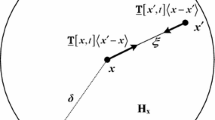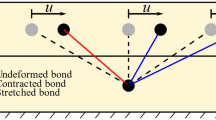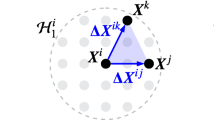Abstract
Peridynamics is a nonlocal theory, and it has been applied to a series of fracture problems based on its two main bond failure criteria: the critical stretch criterion and the critical energy density criterion. In this paper, a new criterion, the critical skew criterion, corresponding to the shear deformation, is for the first time proposed specifically for ordinary state-based peridynamic mode II fracture analysis. The necessity of the critical skew criterion is demonstrated by limitations and inaccuracy of the existing critical stretch and energy density criteria in theoretical and numerical mode II fracture analysis. The validity of the proposed critical skew criterion is illustrated by quantitative analysis of the captured behaviors of the typical mode II fracture tests. The results obtained by the critical skew criterion agree well with the benchmark data from the linear elastic theory, the virtual crack closure technique, and the Griffith’s theory in different aspects of analysis. A simplified formula of the bond energy density is also derived and verified, and it can serves as a fundamental tool in peridynamic fracture analysis.




































Similar content being viewed by others
References
Aksoy HG, Senocak E (2011) Discontinuous Galerkin method based on peridynamic theory for linear elasticity. Int J Numer Methods Eng 88:673–692
Anderson TL (2017) Fracture mechanics: fundamentals and applications, 4th edn. Taylor & Francis, Boston
Bidokhti AA, Shahani AR, Fasakhodi MRA (2017) Displacement-controlled crack growth in double cantilever beam specimen: a comparative study of different models. Proc Inst Mech Eng Part C J Mech Eng Sci 231:2835–2847
Bobaru F, Foster JT, Geubelle PH, Silling SA (2016) Handbook of peridynamic modeling. Taylor & Francis, Boston
Breitenfeld MS, Geubelle PH, Weckner O, Silling SA (2014) Non-ordinary state-based peridynamic analysis of stationary crack problems. Comput Methods Appl Mech Eng 272:233–250
Chen X, Gunzburger M (2011) Continuous and discontinuous finite element methods for a peridynamics model of mechanics. Comput Methods Appl Mech Eng 200:1237–1250
Chisholm DB, Jones DL (1977) An analytical and experimental stress analysis of a practical mode II fracture test specimen. Exp Mech 17:7–13
Dipasquale D, Sarego G, Zaccariotto M, Galvanetto U (2017) A discussion on failure criteria for ordinary state-based peridynamics. Eng Fract Mech 186:378–398
Erdogan F, Sih GC (1963) On the crack extension in plates under plane loading and transverse shear. J Basic Eng 85:519–525
Foster JT, Silling SA, Chen W (2011) An energy based failure criterion for use with peridynamic states. J Multiscale Comput Eng 9:675–687
Gerstle W, Sau N, Silling SA (2007) Peridynamic modeling of concrete structures. Nucl Eng Des 237:1250–1258
Gillis PP, Gilman JJ (1964) Double cantilever cleavage mode of crack propagation. J Appl Phys 35:647–658
Ha YD, Bobaru F (2010) Studies of dynamic crack propagation and crack branching with peridynamics. Int J Fract 162:229–244
Ha YD, Bobaru F (2011) Characteristics of dynamic brittle fracture captured with peridynamics. Eng Fract Mech 78:1156–1168
Hu Y, Madenci E (2016) Bond-based peridynamics with an arbitrary Poisson’s ratio. In: 57th AIAA/ASCE/AHS/ASC structures, structural dynamics, and materials conference
Hu W, Ha YD, Bobaru F, Silling SA (2012) The formulation and computation of the nonlocal J-integral in bond-based peridynamics. Int J Fract 176:195–206
Hu YL, De Carvalho NV, Madenci E (2015) Peridynamic modeling of delamination growth in composite laminates. Compos Struct 132:610–620
Huang D, Lu G, Wang C, Qiao P (2015) An extended peridynamic approach for deformation and fracture analysis. Eng Fract Mech 141:196–211
Jung J, Seok J (2017) Mixed-mode fatigue crack growth analysis using peridynamic approach. Int J Fatigue 103:591–603
Kilic B, Madenci E (2010) An adaptive dynamic relaxation method for quasi-static simulations using the peridynamic theory. Theor Appl Fract Mech 53:194–204
Kitagawa G, Gersch W (1996) Smoothness priors analysis of time series. In: Lecture notes in statistics. Springer
Le QV, Bobaru F (2018a) Surface corrections for peridynamic models in elasticity and fracture. Comput Mech 61:499–518
Le QV, Bobaru F (2018b) Objectivity of state-based peridynamic models for elasticity. J Elast 131:1–17
Le QV, Chan WK, Schwartz J (2014) A two-dimensional ordinary, state-based peridynamic model for linearly elastic solids. Int J Numer Methods Eng 98:547–561
Lee J, Oh SE, Hong JW (2017) Parallel programming of a peridynamics code coupled with finite element method. Int J Fract 203:99–114
Liu W, Hong JW (2012) Discretized peridynamics for linear elastic solids. Comput Mech 50:579–590
Macek RW, Silling SA (2007) Peridynamics via finite element analysis. Finite Elements Anal Des 43:1169–1178
Madenci E, Oterkus E (2014) Damage prediction. In: Peridynamic theory and its applications. Springer, pp 115–124
Madenci E, Oterkus S (2016) Ordinary state-based peridynamics for plastic deformation according to von Mises yield criteria with isotropic hardening. J Mech Phys Solids 86:192–219
Madenci E, Colavito K, Phan N (2016) Peridynamics for unguided crack growth prediction under mixed-mode loading. Eng Fract Mech 167:34–44
Oterkus E, Madenci E (2012) Peridynamic analysis of fiber-reinforced composite materials. J Mech Mater Struct 7:45–84
Oterkus S, Madenci E (2015) Peridynamics for antiplane shear and torsional deformations. J Mech Mater Struct 10:167–193
Parks ML, Littlewood DJ, Mitchell JA, Silling SA (2012) Peridigm users’ guide, Tech. report SAND2012-7800. Sandia National Laboratories
Rao Q, Sun Z, Stephansson O, Li C, Stillborg B (2003) Shear fracture (Mode II) of brittle rock. Int J Rock Mech Min Sci 40:355–375
Ren H, Zhuang X, Rabczuk T (2016) A new peridynamic formulation with shear deformation for elastic solid. J Micromech Mol Phys 1:1–24
Ren B, Wu CT, Askari E (2017) A 3D discontinuous Galerkin finite element method with the bond-based peridynamics model for dynamic brittle failure analysis. Int J Impact Eng 99:14–25
Sarego G, Le QV, Bobaru F, Zaccariotto M, Galvanetto U (2016) Linearized state-based peridynamics for 2-D problems. Int J Numer Methods Eng 108:1174–1197
Seleson P (2014) Improved one-point quadrature algorithms for two-dimensional peridynamic models based on analytical calculations. Comput Methods Appl Mech Eng 282:184–217
Seleson P, Parks M (2011) On the role of the influence function in the peridynamic theory. Int J Multiscale Comput Eng 9:689–706
Silling SA (2000) Reformulation of elasticity theory for discontinuities and long-range forces. J Mech Phys Solids 48:175–209
Silling SA (2017) Stability of peridynamic correspondence material models and their particle discretizations. Comput Methods Appl Mech Eng 322:42–57
Silling SA, Askari E (2005) A meshfree method based on the peridynamic model of solid mechanics. Comput Struct 83:1526–1535
Silling SA, Lehoucq RB (2010) Peridynamic theory of solid mechanics. Adv Appl Mech 44:73–168
Silling SA, Epton M, Weckner O, Xu J, Askari E (2007) Peridynamic states and constitutive modeling. J Elast 88:151–184
Silling SA, Weckner O, Askari E, Bobaru F (2010) Crack nucleation in a peridynamic solid. Int J Fract 162:219–227
Tupek MR, Rimoli JJ, Radovitzky R (2013) An approach for incorporating classical continuum damage models in state-based peridynamics. Comput Methods Appl Mech Eng 263:20–26
Vu-Khanh T (1987) Crack-arrest study in mode II delamination in composites. Polym Compos 8:331–341
Wang JL, Qiao PZ (2006) Fracture analysis of shear deformable bi-material interface. J Eng Mech 132(3):306–316
Wang H, Vu-Khanh T (1996) Use of end-loaded-split (ELS) test to study stable fracture behaviour of composites under mode II loading. Compos Struct 36:71–79
Wang Y, Zhou X, Wang Y, Shou Y (2018) A 3-D conjugated bond-pair-based peridynamic formulation for initiation and propagation of cracks in brittle solids. Int J Solids Struct 134:89–115
Warren TL, Silling SA, Askari A, Weckner O, Epton MA, Xu J (2009) A non-ordinary state-based peridynamic method to model solid material deformation and fracture. Int J Solids Struct 46:1186–1195
Xu Z, Zhang G, Chen Z, Bobaru F (2018) Elastic vortices and thermally-driven cracks in brittle materials with peridynamics. Int J Fract 209:203–222
Zhang H, Qiao PZ (2018) A state-based peridynamic model for quantitative fracture analysis. Int J Fract 211:217–235
Zhou X, Wang Y, Xu X (2016) Numerical simulation of initiation, propagation and coalescence of cracks using the non-ordinary state-based peridynamics. Int J Fract 201:213–234
Zhu Q, Ni T (2017) Peridynamic formulations enriched with bond rotation effects. Int J Eng Sci 121:118–129
Acknowledgements
The authors would like to acknowledge the partial financial support from the National Natural Science Foundation of China (NSFC Grant Nos. 51478265 and 51679136).
Author information
Authors and Affiliations
Corresponding author
Additional information
Publisher's Note
Springer Nature remains neutral with regard to jurisdictional claims in published maps and institutional affiliations.
Rights and permissions
About this article
Cite this article
Zhang, Y., Qiao, P. A new bond failure criterion for ordinary state-based peridynamic mode II fracture analysis. Int J Fract 215, 105–128 (2019). https://doi.org/10.1007/s10704-018-00341-x
Received:
Accepted:
Published:
Issue Date:
DOI: https://doi.org/10.1007/s10704-018-00341-x




